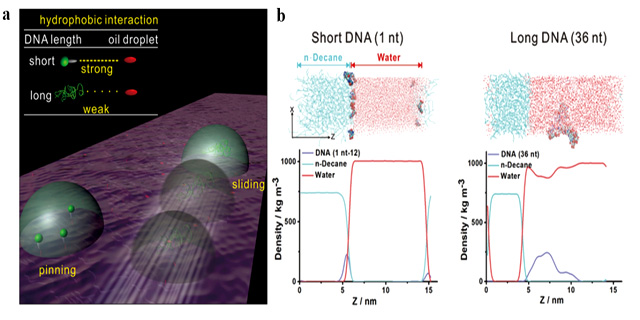A new study reported by Prof. XIA Fan’s group has been published on December 13, 2018, in the academic journal Chem (Chem 4, 2929–2943). The paper provides a new visual detection method based on the droplet motion on the slippery organogel surface and realizes sensitive detection of ATP, miRNA, and thrombin.
Dr. GAO Zhongfeng, Dr. LIU Rui, and PhD Candidate WANG Jinhua are co-first authors, and Prof. XIA Fan is the corresponding author of this article.
This work indicates that short single-stranded DNA (ssDNA) could act as a hydrotrope to interact with oil molecules via interfacial hydrophobic interactions while increasing the interfacial thickness and adhesion, thus hindering the movement of droplets (Fig. 1a). Conversely, long ssDNA generated from rolling-circle amplification tend toward a curled conformation, minimizing nucleobase exposure and leading to weak interfacial adhesion, allowing the droplets to slide easily. The inverted fluorescence microscope and confocal fluorescence microscope are used to investigate the distribution of DNA with different lengths on the oil-water interface. Molecular dynamics simulations are conducted to validate the experimental result that the hydrophobic interfacial interaction is decreased with the increase of DNA chain length (Fig. 1b). With a significant gradient of critical sliding angle, biosensing applications for ATP, microRNA, and thrombin detection are demonstrated, indicating the potential for the detection of a broad range of targets.
This work is supported by the National Key R&D Program of China and the National Natural Science Foundation of China.
Due to the simplicity, rapidness and accuracy of the visual detection method, superwettable biosensor have aroused considerable interest, and significant progress has been made in the clinical diagnosis, food analysis, environmental monitoring, home-health care, and so on. At this moment, there is a huge market demand for visual biosensor. Thus, novel visual biosensing methods based on diverse nanotechnologies and nanomaterials are in urgent need. The research group led by Prof. XIA Fan has developed a naked-eye point-of-care testing platform based on a pH-responsive superwetting surface for the non-invasive detection of diabetes and monitoring of glucose from sweat during exercise (NPG Asia Materials, 2018, 10, 177-189).

Fig. 1. (a) Schematic diagram of droplet motion based visual detection method on the organogel surface. (b) Molecular dynamics simulation of hydrophobic interfacial interaction between various DNA with oil molecules.
(Translated from an article on Voice of China University of Geosciences)